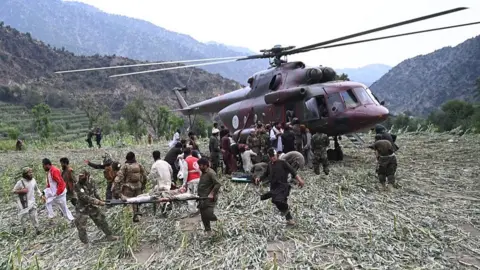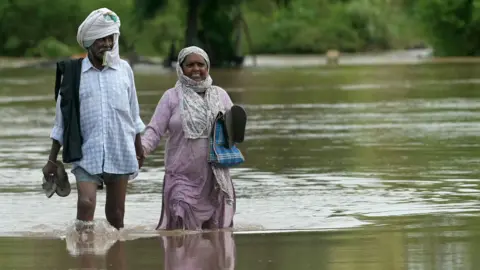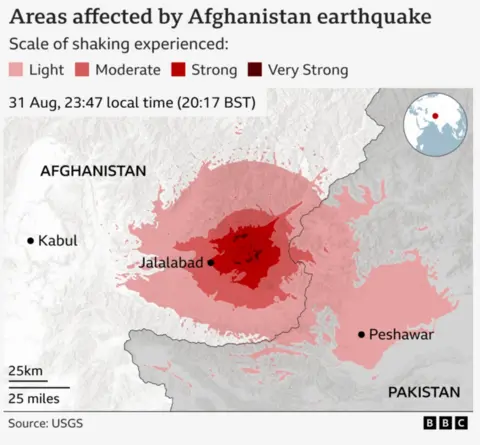Hawaiians are facing a potential tsunami threat after a significant earthquake near Russia triggered warnings across the Pacific. Residents are evacuating coastal areas in line with the advice of local authorities, with reports of waves already reaching several feet high in Maui, Oahu, and the Big Island.
The Pacific Tsunami Warning Center has emphasized the importance of urgent action to safeguard lives and property, advising residents to move to higher ground as the waves may pose dangers for hours. Hawaiian Governor Josh Green encouraged calm amid the rising tension, admitting that though the wave potential exists, he has not yet observed any serious impacts.
As highways filled with residents seeking safety, many in Maui—still recovering from recent wildfires—chose to relocate. The east coast of the U.S. is also monitoring the situation, as California and Alaska prepare for lesser tsunami advisories issued by the National Tsunami Warning Center (NTWC). This advisory indicates that while flooding is not imminent, risky currents may develop.
Seismologist Dr. Lucy Jones stated that while the tsunami could cause harm to ports and property, particularly in Hawaii and possibly California, it likely wouldn't result in mass casualties as experienced in past tsunamis, such as the 2011 Japan incident with towering waves.
For locals like David Dorn, living near the shore means vigilance. Despite having weathered numerous warnings, he and his wife took this threat seriously, opting to relocate their belongings to a loft before heading inland to find shelter. However, traffic flow has become daunting, mirroring the congested streets of major cities.
Residents like Roger Pleasanton quickly shifted priorities, abandoning grocery trips for immediate evacuation as traffic swelled. Meanwhile, shelters opened to ensure safety, and water supplies were shut down to minimize damage.
Felicia Johnson, reflecting on her prior escape during a past tsunami a decade ago, felt the eerie recurring patterns of the ocean and evacuated once again. Packing her vehicle for the night, she recounted the devastation from the Lahaina wildfires while grappling with the anxiety of another potential disaster. "Now, we have so much warning that if we don’t go, it’s our fault," she remarked, underscoring the treacherous balance of preparedness and panic in the heart of Hawaii.
The Pacific Tsunami Warning Center has emphasized the importance of urgent action to safeguard lives and property, advising residents to move to higher ground as the waves may pose dangers for hours. Hawaiian Governor Josh Green encouraged calm amid the rising tension, admitting that though the wave potential exists, he has not yet observed any serious impacts.
As highways filled with residents seeking safety, many in Maui—still recovering from recent wildfires—chose to relocate. The east coast of the U.S. is also monitoring the situation, as California and Alaska prepare for lesser tsunami advisories issued by the National Tsunami Warning Center (NTWC). This advisory indicates that while flooding is not imminent, risky currents may develop.
Seismologist Dr. Lucy Jones stated that while the tsunami could cause harm to ports and property, particularly in Hawaii and possibly California, it likely wouldn't result in mass casualties as experienced in past tsunamis, such as the 2011 Japan incident with towering waves.
For locals like David Dorn, living near the shore means vigilance. Despite having weathered numerous warnings, he and his wife took this threat seriously, opting to relocate their belongings to a loft before heading inland to find shelter. However, traffic flow has become daunting, mirroring the congested streets of major cities.
Residents like Roger Pleasanton quickly shifted priorities, abandoning grocery trips for immediate evacuation as traffic swelled. Meanwhile, shelters opened to ensure safety, and water supplies were shut down to minimize damage.
Felicia Johnson, reflecting on her prior escape during a past tsunami a decade ago, felt the eerie recurring patterns of the ocean and evacuated once again. Packing her vehicle for the night, she recounted the devastation from the Lahaina wildfires while grappling with the anxiety of another potential disaster. "Now, we have so much warning that if we don’t go, it’s our fault," she remarked, underscoring the treacherous balance of preparedness and panic in the heart of Hawaii.


















